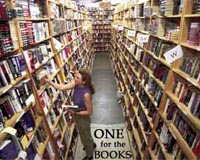 |
Paris (AFP) March 24, 2010 Materials scientists dream of one day being able to place a sample of unknown substance under a microscope and name individual atoms and the structure they form. That vision of a tool able to analyse a material's atomic architecture or spot atoms that can damage a compound's strength or purity is a step nearer thanks to an exploit by scientists in the United States, the British journal Nature reports on Thursday. They used a transmission electron microscope to analyse a single layer of film made from boron nitride, where they were able to distinguish boron atoms from nitrogen atoms, as well as unwanted atoms of oxygen and carbon. The technique involves transmission electron microscopy, which sends a narrow beam of electrons through a wafer-thin sample. Some of the electrons are scattered, depending on the density of the sample. The unscattered ones strike a screen at the bottom of the microscope, creating a "shadow image" formed by interaction between the electrons with atoms in the sample. The core technology in transmission electron microscopy dates back to 1931. But getting an atom-by-atom image has been hampered by problems in getting electromagnetic lenses to focus the beam on the sample, and in damage to the sample caused by the electrons themselves. The breakthrough stems from optics that correct the lens aberration and from a so-called annular dark-field method that is sensitive to the atomic number (the number of protons in the nucleus) of the imaged atoms, according to Nature. The study is led by Ondrej Krivanek of Nion Co., a company based in Kirkland, Washington state, that specialises in electron microscopy. German-born physicist Erwin Mueller is credited as the first person to see individual atoms, a feat he realised in 1955 using a field ion microscope.
Share This Article With Planet Earth
Related Links Space Technology News - Applications and Research
 German book industry faces green change
German book industry faces green changeBerlin (UPI) Mar 23, 2009 The German publishing industry is facing accusations that production of its books is destroying rainforests in Asia, thus enforcing climate change and the loss of wildlife. Germans are serious book enthusiasts. The industry is Europe's biggest, with more than 1 billion books printed in 2008 - that's around 12 books for every German. While reading is to be commended, the paper u ... read more |
|
| The content herein, unless otherwise known to be public domain, are Copyright 1995-2010 - SpaceDaily. AFP and UPI Wire Stories are copyright Agence France-Presse and United Press International. ESA Portal Reports are copyright European Space Agency. All NASA sourced material is public domain. Additional copyrights may apply in whole or part to other bona fide parties. Advertising does not imply endorsement,agreement or approval of any opinions, statements or information provided by SpaceDaily on any Web page published or hosted by SpaceDaily. Privacy Statement |